Shardul Thakur vs Deepak Chahar - A statistical analysis for India’s potential No. 8 in T20 World Cup 2021
11 Min Read
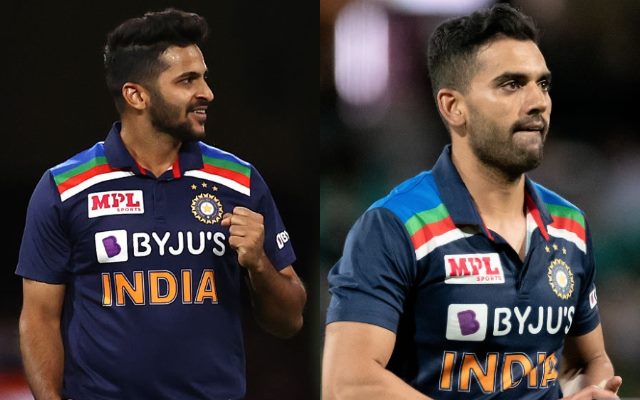

The pandemic has done a lot of things. Among the rather inconsequential of those is the fact that it has changed the buzzword in cricket from “intent”, to “depth”. India and England have managed to field ‘A’, ‘B’, and even ‘C’ teams while other teams have barely managed to go past ‘A’. And it is India’s depth that has now put them in a position to choose from several players for each position in their squad for the T20 World Cup, which starts from 17th October.
One of those positions is the crucial number eight, which should be filled ideally by a four-overs bowler, who has reliable batting capabilities towards the death. And the top two contenders for that role are Shardul Thakur and Deepak Chahar. Washington Sundar is another option, but he’s a finger spinner (an avoidable commodity in T20 cricket, especially when another finger spinner in the form of Ravindra Jadeja is already a lock-in) who’ll be coming off an injury to his bowling hand, and he doesn’t possess the kind of power-hitting capability that Shardul and Deepak do.
Simply bowling-wise, there are other options for the third seamer after Bhuvneshwar Kumar and Jasprit Bumrah, in the form of T Natarajan, Mohammad Shami, and Mohammad Siraj, but none of them are number eight material. And that is what puts the limelight on Deepak Chahar and Shardul Thakur. So let’s try to break down both of their numbers and analyze who is the stronger contender for that slot.
Overall Numbers
Shardul has played 22 T20Is for India and 52 games in the IPL, whereas Deepak has played a comparable 14 T20Is for India and 55 games in the IPL.
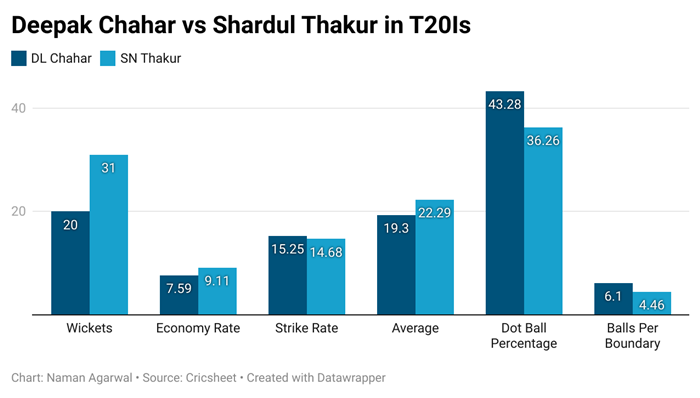
In T20Is, Deepak has picked 20 wickets at 1.43 wickets per match while Shardul has picked 31 wickets at 1.41 wickets per match. There’s almost nothing to separate them on that front. Shardul’s economy rate has been typically high (9.11) as compared to the rather sedate economy rate of Deepak (7.59). There’s again almost nothing to separate them in terms of strike rate (15.25 for Deepak vs 14.68 for Shardul). What there is to separate them though, are the dot ball percentages and the balls per boundary.
Deepak has bowled considerably more dot balls — 43.28% vs 36.26% — and has gone for boundaries significantly less frequently — 6.1 balls per boundary vs 4.46 balls per boundary — than Shardul. The number 4.46 is somewhat alarming, signifying that Shardul has bowled at least one boundary ball per over on average.
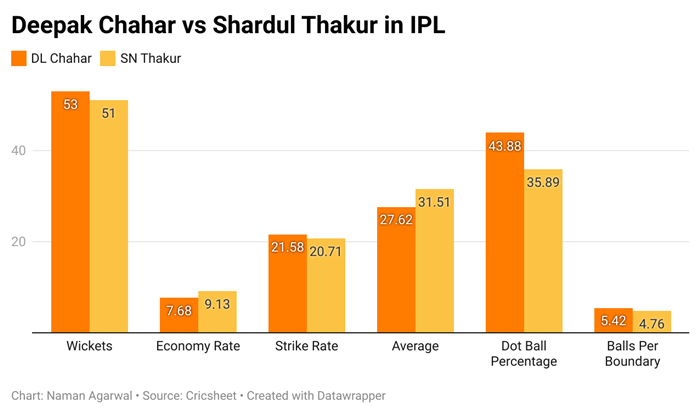
Their overall numbers are not much different in the IPL either. Both have picked almost a wicket per match and have a similar distribution of all the other metrics. Shardul has a pretty high economy rate (9.13) and pretty low balls per boundary (4.76) in the IPL too. Deepak has a slightly worse ball per boundary in the IPL (5.42) as compared to that in T20Is (6.1). He too has conceded a boundary every over on average in the IPL, although it’s still not as low as Shardul’s.
Phase Wise Numbers
The stark difference in the overall metrics of Economy Rate, Average, Dot Ball Percentage, and Balls Per Boundary might make you ask why is Shardul even being considered. But it’s important to note that despite filling the same spot, both of them serve very different roles as bowlers. Deepak is a new ball strike bowler who often bowls three overs in the Powerplay, while Shardul is more of a middle overs enforcer and a death bowler.
That is bound to increase Shardul’s economy and balls per boundary significantly as compared to Deepak. Hence, we must look at their phase-wise numbers and compare them to the average numbers of bowlers in those phases.
In T20Is, Deepak has bowled almost 60% of his deliveries inside the first 6 overs. Even Shardul has bowled a considerable percentage of his balls inside the powerplay (~40%), but it’s nowhere near that of Deepak. On the other hand, Shardul has bowled almost one-third of his balls at the death (17–20) whereas Deepak has only bowled around one-fifth of his balls at the death.

Let’s first compare the supposed strong suits of both the bowlers with that of the average bowler (post-2017 since both of them made their T20I debuts in 2018), and then compare their supposed weaker suits with that of the average bowler.
While the economy rate in the Powerplay in T20Is since the beginning of 2018 has been eight runs per over, Deepak Chahar has gone at 7.27 runs per over. His strike rate of 20 balls per wicket is better than the average strike rate of 23.36 too. If you look at the table above, all of Deepak’s metrics are better than the average metrics since 2018 in the Powerplay. He is a genuine wicket-taking threat with the new ball.
The average economy rate in T20Is since 2018 at the death (overs 17–20) has been 9.8. Shardul Thakur, whose primary role is bowling in the middle and death overs, has gone at 9.14 runs per over at the death. Shardul is well known for ‘making things happen and for his wicket-taking abilities’. That is reflected in his strike rate (8.76 balls per wicket) and average (13.35 runs per wicket) at the death, both of which are 26.13% and 31.1% better than the average strike rate and average at the death in this period, respectively.
Now, onto their weaker suits. Shardul has gone at almost 10 runs per over in the Powerplay in T20Is while picking only 6 wickets despite bowling almost 40% of his balls in this phase. His average is a humongous 49.83 and he has got hit for a boundary every 3.5 balls. To compare, the average balls per boundary in this phase in this period has been 4.9. Shardul’s weak zone is, safe to say, very weak.
Deepak meanwhile, has picked 7 wickets at the death in T20Is while bowling almost 20% of his balls in this phase. What is surprising is the fact that he has only conceded 8.44 runs per over at the death. Not only is that far better than the average economy rate of bowlers since 2018 at the death in T20Is, but it is also significantly better than Shardul’s economy rate in this phase.
In fact, even if you do away with any comparison, it is a world-class economy rate for the death overs on its own. His balls per boundary are also 8.4, implying he has conceded less than a boundary an over at the death. Not only is Deepak Chahar’s weak zone not weak, but it is also stronger than Shardul Thakur’s strong zone!
Let’s check with IPL numbers now to see if this is a consistent observation or just a by-product of a small sample size. In the IPL, Deepak has almost entirely been used as a new ball bowler, bowling a mammoth 78.76% of his balls in the Powerplay. Shardul’s bowling meanwhile has been a bit more evenly distributed. Almost one-third in the Powerplay, 38.78% in the middle overs, and almost 30% at the death.
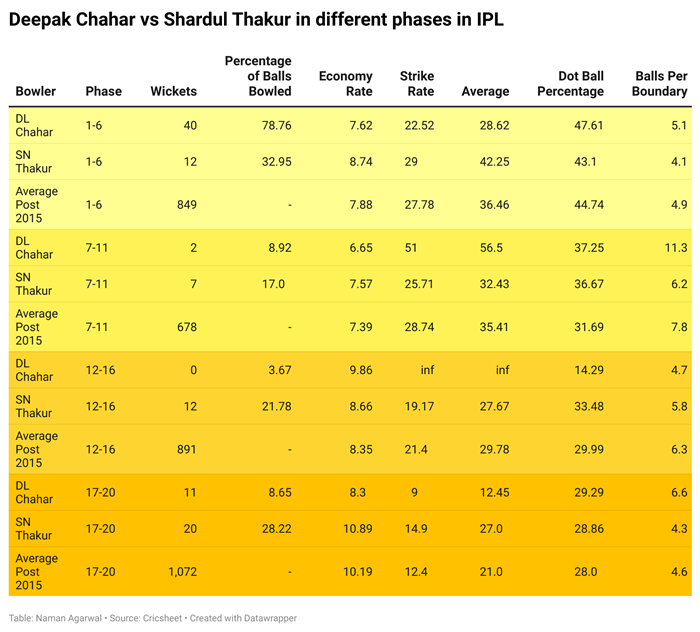
Once again, Deepak’s numbers shines in the Powerplay. His economy rate (7.62), strike rate (22.52), average (28.62), dot ball percentage (47.61), and balls per boundary (5.1), all are better than the average values for all those metrics in the Powerplay in IPL since 2016. His brilliance with the new ball needs no more justification.
Unlike T20Is, Shardul’s numbers at the death in the IPL though, are worse than the average numbers at the death in IPL since 2016. His economy rate is a poor 10.89, 0.7 runs per over higher than the average value. His wickets also come at a slower rate (14.9 balls per wicket) than the average value (12.4 balls per wicket). The phase where he is good at though is the middle overs.
His economy rates in the 7–11 and 12–16 over phases are still higher than the average economy rates for those phases, but his strike rates, averages, and dot ball percentages are better than the average values for those metrics. The boundary ball is never far away with him, as evidenced by a below average ball per boundary in all phases, but his value lies in the wickets he takes in his middle over.
But a similar exercise as done above will again show that Shardul’s numbers in the Powerplay are still worse than both Deepak’s and the average numbers, while Deepak’s numbers at the death are still better than both Shardul’s and the average numbers. It is only in the middle overs that Shardul fares better than Deepak, but that also comes with the caveat of Deepak bowling only around 12% of his balls in that phase.
Impact
Let’s try to look at the percentage of matches where both have had positive or negative impacts.
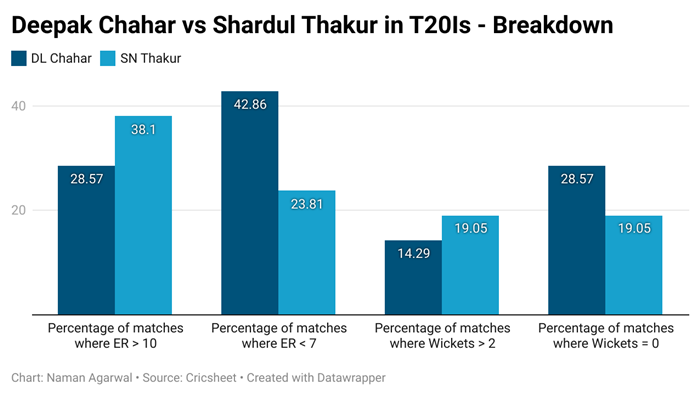
In T20Is, Deepak has been the clear winner in terms of economy rates. He has conceded more than 10 runs per over in almost 10% fewer matches than Shardul while conceding less than seven runs per over in almost 20% more matches than Shardul. In terms of wickets though, Shardul has had a more positive impact than Deepak, having taken 3 or more wickets in 19% of his matches as compared to only 14.3% for Deepak. Shardul has also gone wicketless in the same number of matches as he has taken 3 or more wickets. Deepak meanwhile, has gone wicketless in almost twice the number of matches as he has taken 3 or more wickets.
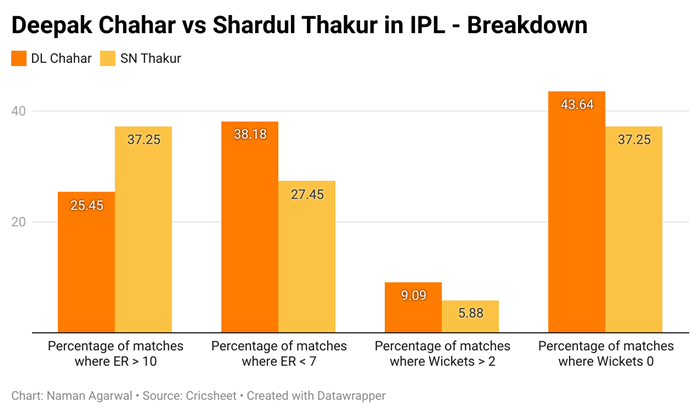
The story’s been similar in the IPL. Shardul has gone for more than 10 runs per over in a whopping 37.25% of matches, while Deepak has done so in only around one-fourth of his matches. The numbers are reversed for a percentage of matches where they have conceded less than 7 runs per over. The only difference from the trends of the T20I percentages here is the percentage of matches in which both have taken 3 or more wickets — 9.09% for Deepak and 5.88% for Shardul.
Conclusion
There’s not a lot of batting data for both of them in either IPL or T20Is to compare. While Shardul has scored 49 runs at a strike rate of almost 114 in the IPL and Deepak has scored 78 runs at a strike rate of almost 140, Shardul has hammered 69 runs in T20Is at an impressive 197 runs per hundred balls, with Deepak having scored a solitary run. Both have batting and hitting potential, and both have shown it on the international stage, albeit in different formats. There’s not much to separate them on this front.
As far as bowling is concerned, both Deepak Chahar and Shardul Thakur are talented, skillful bowlers in their rights. But Deepak has been much better than Shardul in the IPL so far. While Shardul has managed to pull back those numbers slightly in T20Is courtesy of his regular wickets, there’s a school of thought that a significant percentage of those wickets have been ‘lucky’. That can not be quantified, obviously, and it may very well not be the case. But lucky or not, he is still behind Deepak in terms of how the numbers add up.
Since India doesn’t play any more T20Is before the World Cup starts, there’s not a lot of room for a change of the pecking order. With Bhuvneshwar and Bumrah as the two lock-in fast bowlers, the management and selectors will have to choose between going with the bank that is Deepak Chahar, who on his day, can dismantle top orders single-handedly, and going with the unpredictable Shardul Thakur, who offers greater risk, and potentially greater rewards. Deepak seems slightly ahead if you go by the numbers, but numbers in cricket, are not the only thing you can go by.
Download Our App